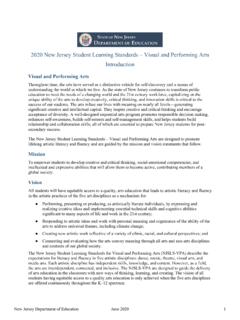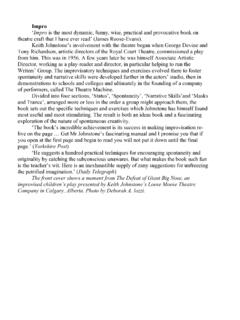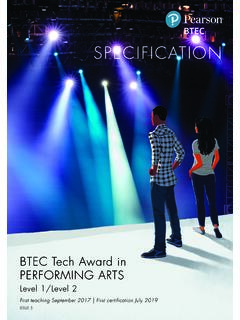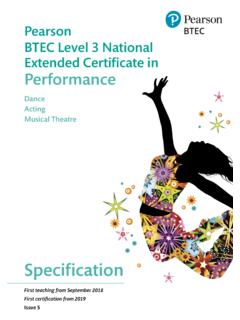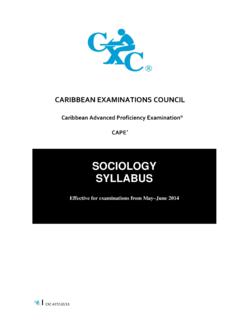Transcription of Music Standards of Learning - Virginia Department of …
1 Music Standards of Learning for Virginia Public Schools Board of Education Commonwealth of Virginia May 2020 Music Standards of Learning i Music Standards of Learning for Virginia Public Schools Adopted in May 2020 by the Board of Education Daniel A. Gecker, President Diane T. Atkinson, Vice President Kim E. Adkins Pamela Davis-Vaught Francisco Dur n Anne B. Holton Tammy Mann Keisha Pexton Jamelle S. Wilson Superintendent of Public Instruction James F. Lane Commonwealth of Virginia Board of Education Post Office Box 2120 Richmond, VA 23218-2120 2020 Music Standards of Learning ii Copyright 2020 by the Virginia Department of Education Box 2120 Richmond, Virginia 23218-2120 Virginia Department of Education All rights reserved. Reproduction of these materials for instructional purposes in public school classrooms in Virginia is permitted.
2 Superintendent of Public Instruction James F. Lane Assistant Superintendent for Learning and Innovation Michael F. Bolling Office of Humanities Christine A. Harris, Director Kelly A. Bisogno, Coordinator of Fine Arts Douglas C. Armstrong, Fine Arts Music Specialist Statement of Non-Discrimination The Virginia Department of Education does not discriminate on the basis of race, sex, color, national origin, religion, sexual orientation, gender identity, age, political affiliation, or against otherwise qualified persons with disabilities. The policy permits appropriate employment preferences for veterans and specifically prohibits discrimination against veterans. Music Standards of Learning iii Table of Contents Foreword .. iv introduction .. v Goals .. v Strands .. vi Kindergarten General Music .. 1 Grade One General Music .
3 3 Grade Two General Music .. 6 Grade Three General Music .. 9 Grade Four General 12 Grade Five General Music .. 15 Elementary Instrumental Music .. 18 Grade Six General Music .. 21 Grade Seven General Music .. 23 Grade Eight General Music .. 25 Middle School Instrumental Music , Beginning Level .. 27 Middle School Instrumental Music , Intermediate Level .. 30 Middle School Instrumental Music , Advanced Level .. 34 Middle School Choral Music , Beginning .. 37 Middle School Choral Music , Intermediate Level .. 40 Middle School Choral Music , Advanced Level .. 43 High School Music .. 46 High School Music Theory .. 48 High School Instrumental Music , Beginning Level .. 52 High School Instrumental Music , Intermediate Level .. 56 High School Instrumental Music , Advanced 60 High School Instrumental Music , Artist Level .. 63 High School Choral Music , Beginning Level.
4 66 High School Choral Music , Intermediate Level .. 69 High School Choral Music , Advanced Level .. 72 High School Choral Music , Artist Level .. 75 Music Standards of Learning iv Foreword The Fine Arts Standards of Learning in this publication represent a significant development in public education in Virginia . Adopted in May 2020 by the Virginia Board of Education, these Standards emphasize the importance of instruction in the fine arts dance arts, Music , theatre arts, and visual arts as part of a comprehensive education in the public schools. Knowledge and skills that students acquire through fine arts instruction include the abilities to think critically, solve problems resourcefully, communicate effectively, work collaboratively, understand historical and cultural perspectives, and exercise creative thinking by employing originality, flexibility, and imagination.
5 The Fine Arts Standards of Learning were developed through the efforts of classroom teachers, curriculum specialists, administrators, college faculty, professional artists, community arts organization representatives, fine arts professional organization representatives, and museum personnel. These persons assisted the Department of Education in developing and reviewing the draft documents. Opportunities for citizens to make comments with respect to the Standards documents were provided through public hearings that were held at several sites across the state, as well as public comment email accounts. The Fine Arts Standards of Learning are available online for divisions and teachers to use in developing curricula, lesson plans, instructional strategies, and assessment methods to support the Standards . The Standards state the minimum requirements in the fine arts, setting reasonable targets and expectations for what students need to know and be able to do in a sequential course of study.
6 The Standards set clear, concise, measurable, and rigorous expectations for students. While the Standards focus on what is most essential, schools are encouraged to go beyond the prescribed Standards to enrich the curriculum to meet the needs of all students. Fine arts instruction in Virginia is responsive to and respectful of students prior experiences, talents, interests, and cultural perspectives. Successful fine arts programs challenge students to maximize their potential and provide consistent monitoring, support and encouragement to ensure success for all. All students, including gifted students, English learners, and students with special needs, must have an opportunity to learn and meet high Standards in fine arts instruction as part of a comprehensive education. A major objective of Virginia s educational agenda is to provide the citizens of the commonwealth with a program of public education that is among the best in the nation and that meets the needs of all students of the Commonwealth.
7 These Fine Arts Standards of Learning exemplify the expectations established in the Profile of a Virginia Graduate and are reflective of the skills and attributes students need to excel in the 21st Century workplace. Music Standards of Learning v introduction The Music Standards of Learning identify the essential knowledge, understanding, and skills required in the Music curriculum for each grade level or course in Virginia s public schools. The Standards outline the minimum criteria for a sequential course of study within a comprehensive Music education program. The Standards are designed to be cumulative, progressing in complexity by grade level from kindergarten through several sequences of high school courses. A comprehensive Music program provides students with the ability to achieve the goals established in these Standards , and to understand personal responses, and the responses of others, to the many forms of musical experience.
8 Students develop individual voice and expression through individualized instruction and multiple group educational opportunities. They gain the ability to work collaboratively to achieve common goals while preparing for a lifetime of engagement with the arts. These Standards are not intended to establish or encompass the entire curriculum for a given grade level or course, nor to prescribe how the content should be taught. Teachers are encouraged to go beyond the Standards and select instructional strategies and assessment methods appropriate for their students. Teachers are expected to consistently model digital citizenship in the legal and ethical use of resources and source material. Goals The Music Standards of Learning support the following goals for students: Develop understanding of Music through experiences in creating, singing, playing instruments, listening, and moving.
9 Think and act creatively to transform ideas and emotions into distinct forms of musical expression. Understand and apply a creative process for developing ideas for creating and performing Music . Develop the ability to read and notate Music . Develop and apply the technical skills necessary to engage deeply with Music . Develop critical thinking skills through the analysis, interpretation, and evaluation of the work of self and others. Articulate personal responses to musical works, and recognize diverse responses and opinions of others. Identify and apply collaboration and communication skills for creating, developing, rehearsing, and performing Music . Demonstrate understanding of cultural and historical influences of Music . Develop a lifelong community engagement with Music as a performer, listener, audience member, supporter, advocate, and consumer.
10 Identify and adhere to ethical and legal Standards for the use of intellectual property, and for the safe and ethical use of materials, equipment, and technologies. Connect knowledge, skills, and personal interests in Music to college and career opportunities, and to skills for the 21st Century workplace. Understand and explore the impact of current and emerging technologies, tools, and innovations on Music . Cultivate authentic connections between Music skills, content, and processes with other fields of knowledge to develop problem-solving skills. Music Standards of Learning vi Strands The Music Standards of Learning are organized into five specific content strands: Creative Process; Critical Thinking and Communication; History, Culture, and Citizenship; Innovation in the Arts; and Technique and Application. These strands exemplify the expectations established in the Profile of a Virginia Graduate and are reflective of the skills and attributes students need to excel in the 21st Century workplace.











